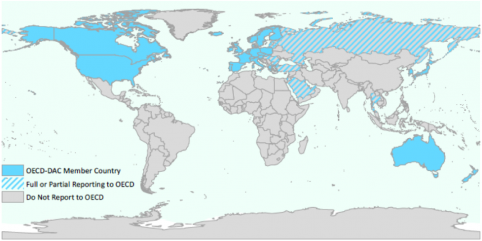

The OECD DAC’s list of member countries and coverage of development assistance data look increasingly limited in the context of emerging economies. (Source: OEDC, World Bank)
Development cooperation as we know it may soon be redefined, literally. The OECD Development Assistance Committee (DAC) is attempting to agree on a new definition of Official Development Assistance (ODA) and is aiming to reach consensus by the end of 2014. In the murky, ever-evolving world of international finance, such definitions are central to how we understand and allocate aid.
The landscape of development finance is dramatically changing as former and current aid recipients increasingly provide diverse forms of development cooperation themselves and challenge assumptions about foreign aid. However, our understanding of just how big a role these non-DAC countries play is limited by existing aid definitions and reporting mechanisms that do not capture all, or even a fraction of, their assistance efforts.
This is why we are starting a conversation about these definitions. In this new blog series, we will examine how standard aid definitions have failed to keep up with significant changes in who gives aid and how. In addition, we will discuss alternative definitions and understandings of aid promoted by non-DAC countries, considering how these might inform a more inclusive, broadly acceptable definition of development cooperation.
When the OECD-DAC first developed the definition of ODA in 1969, it did not fully engage non-Western countries that were already providing aid. Efforts to engage these countries have improved, but many of these non-DAC countries now object to fundamental assumptions of ODA: the direction and sources of flows, the nature of concessionality, and the way that aid serves economic and social development.
The OECD’s ongoing reforms of development cooperation definitions represent an important opportunity to re-engage these donors by exploring alternative standards for measuring development cooperation, beyond ODA. If these reforms do not fully engage non-DAC donors (as some have suggested), the reforms risk quickly becoming irrelevant. A development cooperation definition that fails to encompass the growing landscape of non-DAC donors is not viable in a world with globalized challenges that demand broad, inclusive partnerships.
Because many non-DAC countries do not feel that ODA effectively represents their development cooperation, they report only partial aid information to the OECD, or no information at all. Instead, some non-DAC countries have developed alternative methods for measuring development cooperation, within the framework of South-South Cooperation, as we will discuss in forthcoming blogs in this series.
The OECD’s ongoing discussions on alternative definitions of development cooperation provide an opportunity for non-DAC countries to present their unique development philosophies. Engaging in these discussions will ultimately increase international recognition of their significant contributions to development cooperation. However, this should not prevent non-DAC countries from further developing their own standards for development cooperation, which themselves are important contributions to the global development landscape.
As our research team tracks aid flows from 70 DAC and non-DAC donors, we’re learning a lot about the challenges and the questions that emerge when trying to compare the contributions of these two groups. In the coming weeks, we’ll be exploring several of these questions in a new blog series here on the First Tranche. What are the limitations of applying existing ODA definitions to non-DAC countries? How do the principles of South-South Cooperation support an alternative philosophy of development cooperation for non-DAC countries and its relationship to ODA standards? How do these principles relate to ODA standards? We will then take a closer look at issues do the BRICS and Gulf Cooperation Council (GCC) nations face in providing development cooperation versus countries in unique to specific groups of non-DAC development cooperation providers. We will also take a closer look at aid definition issues unique to specific groups of non-DAC development cooperation providers, including BRICS countries, GCC countries, Central and Eastern European countries, and Latin American countries, and questions such as, how should DAC and non-DAC providers of development cooperation approach export support as a cross-cutting issue?
We hope that this blog series provokes questions and discussion around alternative methods for measuring development finance, adding greater depth to discussions surrounding the reform of ODA. In this effort, we do not seek to fit non-DAC countries into external standards, but rather to find some sort of common ground for reporting that will help us better capture the full picture of development cooperation.
